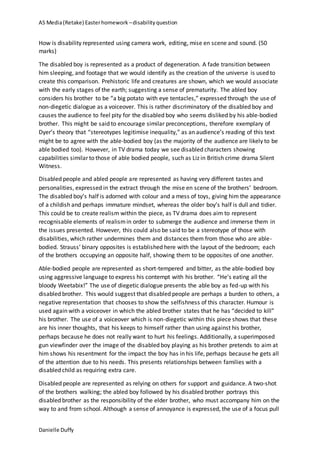Media easter homework disability essay question practice
- 1. AS Media(Retake) Easterhomework –disabilityquestion Danielle Duffy How is disability represented using camera work, editing, mise en scene and sound. (50 marks) The disabled boy is represented as a product of degeneration. A fade transition between him sleeping, and footage that we would identify as the creation of the universe is used to create this comparison. Prehistoric life and creatures are shown, which we would associate with the early stages of the earth; suggesting a sense of prematurity. The abled boy considers his brother to be “a big potato with eye tentacles,” expressed through the use of non-diegetic dialogue as a voiceover. This is rather discriminatory of the disabled boy and causes the audience to feel pity for the disabled boy who seems disliked by his able-bodied brother. This might be said to encourage similar preconceptions, therefore exemplary of Dyer’s theory that “stereotypes legitimise inequality,” as an audience’s reading of this text might be to agree with the able-bodied boy (as the majority of the audience are likely to be able bodied too). However, in TV drama today we see disabled characters showing capabilities similar to those of able bodied people, such as Liz in British crime drama Silent Witness. Disabled people and abled people are represented as having very different tastes and personalities, expressed in the extract through the mise en scene of the brothers’ bedroom. The disabled boy’s half is adorned with colour and a mess of toys, giving him the appearance of a childish and perhaps immature mindset, whereas the older boy’s half is dull and tidier. This could be to create realism within the piece, as TV drama does aim to represent recognisable elements of realismin order to submerge the audience and immerse them in the issues presented. However, this could also be said to be a stereotype of those with disabilities, which rather undermines them and distances them from those who are able- bodied. Strauss’ binary opposites is established here with the layout of the bedroom; each of the brothers occupying an opposite half, showing them to be opposites of one another. Able-bodied people are represented as short-tempered and bitter, as the able-bodied boy using aggressive language to express his contempt with his brother. “He’s eating all the bloody Weetabix!” The use of diegetic dialogue presents the able boy as fed-up with his disabled brother. This would suggest that disabled people are perhaps a burden to others, a negative representation that chooses to show the selfishness of this character. Humour is used again with a voiceover in which the abled brother states that he has “decided to kill” his brother. The use of a voiceover which is non-diegetic within this piece shows that these are his inner thoughts, that his keeps to himself rather than using against his brother, perhaps because he does not really want to hurt his feelings. Additionally, a superimposed gun viewfinder over the image of the disabled boy playing as his brother pretends to aim at him shows his resentment for the impact the boy has in his life, perhaps because he gets all of the attention due to his needs. This presents relationships between families with a disabled child as requiring extra care. Disabled people are represented as relying on others for support and guidance. A two-shot of the brothers walking; the abled boy followed by his disabled brother portrays this disabled brother as the responsibility of the elder brother, who must accompany him on the way to and from school. Although a sense of annoyance is expressed, the use of a focus pull
- 2. AS Media(Retake) Easterhomework –disabilityquestion Danielle Duffy from the abled boy to an older man sitting at the bus stop presents the abled boy as protective of his brother, as he does care for him. However at the end of the extract we see that the abled brother is persuaded by his friends to leave his disabled brother to his own devices, which could represent disabled people as abandoned and outcasted due to them being a little different to abled people. When the boy is left alone he is shown with an anxious expression showing his insecurity taking the bus home alone. Ambient sound of children laughing and chatting in the background perhaps emphasizes this exclusion and makes us as the audience pity the boy. In conclusion in the extract I think that the representation of disabilities is that disabled people are often incapable of mixing with able-bodied people, and receive extra care in comparison to those due to people viewing them as vulnerable and needy. The audience may develop negative preconceptions of them as weak and unapproachable. This archetypal representation is rather outdated these days due to developments of the role of disabled actors in TV drama, and as a result we sometimes see them taking on significant roles.

